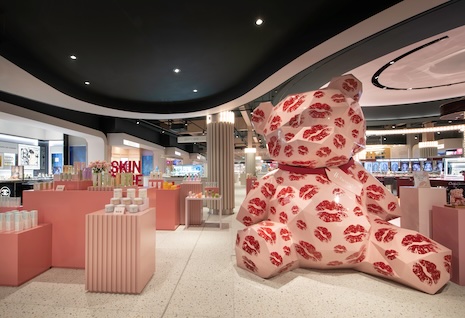By Ewald Damen
Retail stores have transformed over the years, driven by consumer data and shoppers’ behavioral changes.
With the help of this data insight, retailers have shifted to consider aspects of the shopping environment beyond shelves, rails and mannequins.
Additionally, the rise of ecommerce has pushed the physical store purpose in a new direction.
 Harrods' H beauty store in Lakeside. Image: (c) Austin Hutton
Harrods' H beauty store in Lakeside. Image: (c) Austin Hutton
Creating a pop
Intensified competition, rising price points and service levels have meant that brands and department stores that have not adapted to a “new way of shopping” have lost market share, resulting in some well-known casualties such as British department store Debenhams.
There appears to be a common thread among stores that have fallen behind – they have not adapted fast enough, losing track of their customers’ needs and desire for change.
If brands want to keep existing – and attract new customers – it is essential that new shopper behaviors are at the centre of their strategy, particularly when considering the in-store experience.
This is where the shift in retail design has taken place, so that retailers are designing and creating more adaptable environments that can be customized and changed depending on the location, shopper segments and other broader environment impacts.
We have seen retailers embrace the concept of a core canvas in their store design, one that involves a universal backbone but with elements that can then be designed and changed in keeping with the specific needs of individual stores. So, the space can alter and evolve for different brand takeovers, seasonal experiences or partnership pop-ups to draw in different audiences.
This transformation has been evident in recent years through creative briefs which are now much more focused on stronger brand expression and an “embedded canvas” for activations.
 Harvey Nichols' store entrance in Birmingham, U.K. Image: Harvey Nichols
Harvey Nichols' store entrance in Birmingham, U.K. Image: Harvey Nichols
Tech talk
As retailers want their physical stores to become more experiential, must-visit locations, their brand expressions within those stores have had to change – to be bolder, more enticing and crucially more varied. We have seen this with brands such as Gucci and Balenciaga.
Technology has had a huge impact.
Social media plays an important role in allowing more people to see what brands and retailers are doing around the world, raising expectations in terms of store design and shopping experience.
For instance, shoppers in St. Louis now know what those in Shanghai are accessing.
Technology also impacts the design itself with examples such as Burberry creating strong digital and social media links with their stores and especially their Shenzhen location.
Ethical and cultural considerations are having more of an impact on local interpretations of store designs, fuelled by factors such as reducing carbon footprints.
Moreover, customers want unique experiences in different locations.
 Ewald Damen
Ewald Damen
Sustaining interest
A sustainable approach is now the gold standard in most aspects of life, and retail design must follow suit, emphasizing recycling and the longevity of stores and material sources.
A sustainable core canvas means those central elements stay the same but can be adapted for changing preferences without having to start everything from scratch.
Iconic, historical, upcycled and restored buildings have become a new preference for brands selecting their retail environments, offering the added benefit of connecting with local communities and becoming a must-see-and-visit destination.
This bold approach extends beyond building and design to include the services and offerings within stores.
Many respectable stores now feature coffee machines or refreshment options, and services have become more relevant and bespoke.
Flexibility in retail has shifted from adjustable shelves and rails to complete store transformations.
Expressive campaigns, brand collaborations and art installations provide a welcome transformation to re-attract customers to the store environment.
Pop-up spaces allow for full, seasonal takeovers combined with online and offline events to help communicate creativity and innovation.
 Harrods Prada Fendi carpet. Image: Harrods
Harrods Prada Fendi carpet. Image: Harrods
THE STORE ENVIRONMENT has become a product itself, promoting the brand and its wares, fostering stronger brand loyalty and encouraging purchases in-store, online or through third parties.
With a core canvas philosophy, bricks and mortar has a renewed purpose, a more adaptable framework and a better orchestrated strategy to serve the brand in this increasingly complex shopping environment.
Ewald Damen is creative director of Virgile + Partners, London. Reach him at ewald.damen@imagination.com.
Do join us at Luxury Roundtable’s Luxury Retail Forum New York Sept. 12 and meet the top executives and experts in luxury retail sharing insights and strategy on how to navigate the highly competitive luxury shopping environment. Click or tap here to register!
{"ct":"JPkCe6xQzw5g37OK3vvHKi9cV\/b4QsR9GLEVfSwqf7Iax1pneUmqZSBG\/Xj4+PdutQxCnVqEy3cEDJFgredA27RfTu8RvuvvX6Yb4kp6MVvEjwPdHNAeDMt18sWRbFYfziYeAfM24VtsiUzikfR7k74t5FzeCkGcBCyV2s02m+zHN6\/u378dR\/fYDADPMT3Bw2ioZq6YQHPdgW\/Iv0b4sTgBoGIF0IBaTVx1AVx6ApHQJcyep4pakTIr5xE3G\/NAx5nGjm5vMm3NzjiW2zNPAJjnjyHBfXNVgZIxA70lmeIy6kBboQ9Frs6Jd0y3xEZI9WmS0nKd5vXqKI0uTDXpItP+mMt0qhB9pzKmrK4zUOvnRBgoiEIfuQ31Z7BhC9VTXy6rlDMFr6cqxg9WuB9I1YC+X4MtiedbKqtEbfCnAHmkVVcPVXkVLIjL72lhiNIvkAZHOQFy5WlIcIj2FX8Q9Ry9S1zky9uXPAtCxK\/4kxSKB4klobm6iFH11qfM2PcW5Gt7j9WP9lucr+V04QpZ6Z5aLxl7M2ACF5fEQVCULAptQ1gD2jNoT2OZst1g54ymRYo1\/MLm6\/ZA4HWWmaUab0DEhVheq7YQwxJy1mZ0EE\/2SarCWV5Vm5wOgBlpA8XEDnNRRhbjqdYO4s6xlPNBEdM9HhvxDhSzMFtaqYRfUCxdQsoF0gdafgT\/Z9dLi63fqIOSC7b3c9CFGYi2XcHN5d1qB3N1L\/Lehkzz7KA4+FPFTAGFZ8zcbdVtrRAevCSJA1ZP+GtYhhkBUilxEdYw9dBvA\/5a9\/vvbFAbQprENqE\/K71\/U2C9JnaSmF+jmqPUJQagMO0KMzwcXO\/vCX1C2syFZKcMzEPGaQoiGnz+H2eZxXSHMCB4EDiGVA5ZkY3kdxaKO\/19EfvjtfG65dThRxgX2YTlK6XxdtYgcSAgFdVQNlzvAV2iauwZenzTDPwEt+5\/+UKXT1jEMKSPhob0DlMHGzcndKk23i3KHhWIi\/AeVQ+IPbiUx1ouOEABMNKARIawd2S6N1WSr2XjZs9\/RpyXX34WUZI5Kl9eZqoFjG6Dk+GdmuyjzCIrycOozaVvjb0\/mRU9hBJfSTbuFux7q0MP5lDIHCM+NprQi8SzB6IRplSK0bVgCNVoDLYRd8IeDXll\/nXTwFxzs42whv4z0lr2+Pp4Kdzek0\/xf1K8KK+z5f68bQRz2n2nkon3ny4LtWJkZPXkhZPsiKdYik6nseLd5GYUXeVK4MxPe04oMQj8nG+jyQcZimY1GHuVmzN\/UNfw8cIUvzAPgFZlYMX3V2kKVR1TRSOeG\/Mx0TtMVfbDqut17w+iroCLCH+a1+xb1jw8eWV5kt9bS6V57fgBZ8aYDg7QSFCub6TX\/JAeRbQmeh9C6axl53DEV\/sEtNIMiYV5mFiTRdhPIDd6NCV48FgOJxN4Wy0brpFBXZGwU+8DVAuUWCXN\/D2\/p7EdSbkogmSZEfZVj3vj4VlfZqBUpi1bbJT5l8IW4Av1SQGdq6r0XIiBDwiH8SM2hge6Q05hJhPOjxNLFCULzK1D4h91oQEo9vteFUnRrcPDbOrdyXntWpf5jCXYFh60ScSx1S6clhGh32et26ORx5RAJeRh+R0QZoEgoIFwWulwHRrTixiipvs+sS9oxtJMeV5fnyJs5159zQuccPpOuKi3Qd15rQEStq5Kjiz10rqA\/ZIR8dwfNQlX6\/75X3zCd1TdV3EkATbDF2BTRcchjOGyJ07JW0jMeCGH8Uoop4I4jiv\/WHcllY+0VATfbESmsKB26Kxdv7OBYK34NWQrmkHD+eIDp7FFIihmZXomVQX3Y+q4IYV9\/q8XPU9Yw59gKvt1R0HWbRNLnzP+STG2ThLpNFYfGZiyw\/PhasNkg1nlHuK4iwbiSEtMw0PaW3WkcV6UuZZ9I\/UWBmvfy9+vnWg9jqGaDAXTosBC2x21DCSUY7WWmhrl+Gug5ME5k1rY1X0aM96DFy2ml0rBZ88\/higlOGtW+mlS4KpT1G03UuylUFf7s\/Yguc4VG7eVANVk9fCXLInANSRbWVNy3ZlvXHSIR1G5uGXNDDXeHR78mvxQZLIUqoE03rER6OG\/KzCj\/J6N2KJOYTZnXXVku+z41\/dfDx1WoHmQkUnY0XL5MvsB6szRqvcvj7vYQuQtSReWKOZ8Hndoh2l6b+++uOYkZjGgoMiBoTj4TPoYyaS9eyjgfqur+c\/jV8F+dQXffXXpEiVVq3W5k\/10s89BmqpgNbNsu1lVwSVuJ6DxdyL2ROZ8YcFk0iAxUWz2f7Hc\/6UmXozAodPVUhjCNx6Xq79C51Dl0oS1vC+dtY\/y8EMz8DD7vjlOl8MWaEgw\/k\/4EvWKvowOXLKV8SbFGR33ZPmUUUHTtK3OkxNQiT5fskCyLPuLucFbupLaeQ+SEic+45emQepDZi1gPvq4aCOKTWAOh0lFRtO2H4DYwY9ads8dH7KHlE3FJB+43TUtvlvVoYwhs3wtCtsn9rWJzjtOTg33XoiS8kIYw84DWFQ7vuH1z1aaKnVE\/6FIQVBD08k50sVnMKBu0nfLOWmiXGxwGCTq76G7hoPbR\/NpI0\/9icDzbubnPQhcSW4COjq404npJoADaisOVgZIesuHdWyBWn7Zl6xUYe8y+sthijRCfQ5mY+g5Mx+ordfqtTqkqERqggD+hVZpC+IGLk3HoHkilT4Q3aZ+UXzGWZE7ewzVB5bCDn2hUqSicmZPHLxr7uujvHmJCsvxQm4Aggw6r9M0d6SlUMIQG\/WVIdZ+n4yhC\/CKa8mVsGkg8r26hxYO6M2RHRBCssusZU76USWNJrRJWoo5vl2SbDP8uM+bVyiMGQyfhhWfIH0rPrw1mpmIM96GpPT5+NDXR8BDjMxgk0SyPDDdP76OUOamT2\/Ug1nHDYExTLk5m5rNAseEHeZZxQC9maRN3IubAeqAOaa04xtV\/502A+SbpW\/MT27bAy5Eeyz\/+3V2RXxuiR5FYyzBmXzI9T11rqUI+24p6xqJ8JC4Wk3wY\/6eX9aXJnqowjxEO1wXgma\/wA1L6QYRxyNy82RMTgvaZpsRRetNuf3rMXv4a5SWz1\/XyJ3xIjRxhWsWust0jzBq4w\/9rDDx3fzKMnMIstMr748I7VGlk0bXlhFDsKuvauLEEf4ydPz3TONgcODr3HUpXGf+IJmnIuqmU5BP3TE3fiNcgG2x0sypNuSxDhGccbsITUUsg+j6HuiRon0QWUd7egTlwmsedPSxwR9iMFa565Q9HrcEvgx7QPFrIUZFCteLrt\/kaTtZTEoEU8cDKmlYdQBvEHEviQZI6mT+Of41tNFyunoZCIOghjO9j1Zlwu9\/VR\/FTiF3X6a+bd80bJftDknhPBYHia3r65bFW7HZ9\/MgYUFzw49QSWU3fP4u2Vi5UrM\/BIny4QMKIaaXGZu1+cAJ4fightFZ2GiFPdQWwAcfmEQlVaijAstG+qIFqEPLo2ptm4hR75N8gAubK4fpn7zK9imQ\/vQ5URSl\/ds88Wa908BR2DMhDj24fcw7ZufIKZaXFCbCjq8WqzK9ki71pEP\/7r8QEzusHALJ6mukfZqhBfGx6YvAts\/7Z8HjB0BgWepS905eXNkDrISodXyk8NW2hIrv3ic+W8hafZfi0+Yb2yvcwvc+x7XVKbqAIKK8GNz6wgKUo1QB5NYpRfOWeP\/UoBaCNJWiW\/8e44J1AcUBIHaqPgjI+9UBEstniXvHKNDSK+nPabiRLP1e\/bZszvUMwAphBxDIn7U5+nChhwMmFJjJagsEcJCyMSwyh9xzI1Z8EBY\/7khAEesVzziIGfAZK9sHMEwnMQwGYjHyWKN0rHvu5FhM3raqIKohGQn9lcQHm4oxi\/vZuROqJGLlOnMzrjNBtG9PQA5O5xEnSdezRkHkFHAG4yh9hmUT2M+jgFG1JUutLbA1dVxKJeuj\/m4YqEtLNFvdyfIHqK67kyjlCZSf2nKcmNsAD0dg07Atpws2zKdNYbFqEUc5TkSPc2\/PRye0LcAYktwmBYtQg6k3f64j8Pgw316SexOL\/R62BPd\/tBLuJC3Kcg8j\/D52ibpJX\/EHja0pqUEqgF1tvJl5T0NJ8+sQ0rCvEiZ\/7ywhF8H\/W4XN1GPzTcXFnv3gLBXd5Qh0bqpRkL\/2uxeh4wu81qRX+t9Q09Lj\/wRbnCIvtjR+o4\/6\/3P6m1QmuGReN0b2S05lEEXbCj6E4Pd9WTfZHM\/sCQ13rGXGhrzSWr24qxyaKEosfDIs\/IhR0pjTJk+4rFGxrhhzN0qklEwDtn9\/NB97I69oODkL37SQCNZ23jMHX3089h2UOOmwhLLzf7gh90BQg11IFMwJiSqSDgQa+6manA0fV8FPMsjd9evQNL4CDAqS1CG3kihy1N1u1FAMKd\/Xn1DhxXB9c4rJrQCIC+JSwH4cXGzUJF9yodgU0FVGcKuQQqcWplW6rd6KRB+15BL9GYOVRxZwDNGXFrSmh3BR4trX+xX9HsPeJ8rSR7r4Szm4y5cBV9+wDRvVhipx6hyJccIOKzqIk1nr2SYDNvmt5ex8\/8SaOy6tcTRIaJBILw2LGmxmnn2YkW4GiPfK8wX6oYvVfm+8kmHOnCBkqly+C020JCtMpuUx7j6y5zWVEOxpMJZeSrLJZtGKzsRGlz1dXQuyp6X9DZldF\/\/QJD\/0JFOHe+0hevxzsr4gAfKIb\/VzfDw99nAb+hgPwPToxNIlSLjhLAf2L\/3wWmkyrg26maqrEMpb7sHIqMdXBFa3TBDo+oREebcIEOvrUVigJwffTWPeNeQXQxmVQdMQoWx5Dyjvl5Kf43NCdKb3xUgDeNhbaAkApbEYw0LkeHDpRe9lLnTafed6\/zt41vYXnW2aKgcuwIRXrAnsQTR97xRjF+CNX65MfPiQjbZ5kyE8RSZ6oftFf57vNi2md6RjDzDqgB938P1hO95hAqkbwp76DZEOjrsG2whUHYhDrCqn85ea3jeG+\/UodAN\/R1Zsk15UxQQcKsP\/jXY3g3tKA1HrRJalnEAPLzmh\/hlCEV5h8v6p0Z+XGahfwK26QghmJro2oEcTLuOpXmIH7G4Lz0aBwVazWmaAGNuOJvavpTr1yn84JchzJBuouZHhgizMPc91cfI3eYQ8SnBXMW8CCAG37NreoLIGVVgt4r1StBktIDYTPGqp5i4R\/kHxHo4KhuC1N4CZJ+rWzU9UaBNIS2hWCRLhWSletUWMqb98YXAL49gJvoSNdTa0HyCxV1LATqS1MJnbSNsXS5EwORmW6i9jrbYXTpL2zEYM+rcBNOhIvvqka69Z+\/tafKJahNSR2HJcfQzfYEZteE+YgfsatmCg0LEbFa66Onh1riEkwNPYyLf1wcCKRn4YY\/bRdT248tC2xaw8j2MADpEs1NS96uTZbxU8XKNJlz+VHRqaWsPMha9m6CyJExVx4LBvvxjA\/kQ0OxaCUn+LtlTUEM7weub3Mz1BPScvfofyXsH6wgXInQJUNae32vHP0WeUAJFaO2aq70TevulNvd1FJLQGERZvVQMd4C3+pj9a9HhLuUgmMVj5J6EnEGha7kALZRX3FmGSMpmSlGVxYKK95XAT3neyx1mWOrfYh0J0VAkmC+viQPyMXsNd4k4To\/HZI8lDt0jRDa9cw5S0YFFpS2tbBVRs1zP5t00KlZLi6Ra5rJASWhGyY\/Dwj1ck1+OmbpTPlfieskoSeBsI3GuUt0G3fxM2huIhu39D+MjC1fT\/\/B97Yp\/G2KHoqVbrLIADQd9TUZuqDOuu0chvgrbSv\/H0nxd\/rknNWfwMvfo9Y4sq0yhF67mUCEPW8qCNX3f9A5SETsdPH8ca8sdJ9HqF0521D\/PpkZQFozDFd0nE+b0s2LasYSPOA\/QBL7oBn6RekKPBCxiHO15DOklcrNop4rptqnm4TIf\/glQJktjjcM4FnUhomR\/DAtgxvnXyzByxIuLU4C2B8OQfC37rQopSVdA7agZ4GwWcufkcNwgSLwOfuFGZiA5on0F9w\/BFCp+UXtRP9yT\/fgcYs5NV+50Uzc+5BTvg2kN+N5IUhS27bNas4Y2VnKqY1LAdj0ut3V0N7Z4worNkelX1fqo2qcqyCOhXHR4h7Y5zcK5SXoHjw54L3GlbsPuoiFt4Fns3qKeGFKoJ6XsMBYgcOVfuMs\/b4j71WuGJlhv7jw\/Xq4RzH4J0PXLGm2CFFDpHPmsFqDkQuV4vMDNaAatypow6FqFUdRqsdI7anOwXJyBOcJJVmdz3vsTnShOGVXWCX5Q01IfWPjwMs\/yZzqDklcFzsHUwNJVqdqtMn7welnoXE33LaM37LyTyx0dVcAk4kKUTdR9XOao32ll+UZcuhWayF192FyjpOelzAb8Aboo5BwOAxBnD62Z5XfgvpafoRVsaMA3JR6rvH75rMa4jbDqPY5VMgj3FmTxzpvwlJZ7odRVRjCuJD+BKMM36Qkx8IX\/saVbi7iHVSH\/LrdfYxbD+w1h9XIu0FF4Tlfi61wCLvYqdhGhsBDcjcL8P11rT1XaWSKHhS1m29tZaYDiuJAbkWqwW\/he4Xf5wghL6WN3HmhRKO57NVa5NzmUj3MUWRGU8iqsTvCyoB3PP52WZ9\/TUVrLyzEXUOW7a8aKs62QOMy9CxVPT2+93TE2wsbnsOFG+hpL5K2QELsqLU4df3idFAoNds7OiI0z1phCJk6k45uOv0b0cYz3L9OJr7YOMCB71BO2+1se7gMuGk8JjlhShgpDGhLZ\/XeG7lbpGmF\/GPYXHtE7PY8iZasZTpVr+DvTUHaUReY38edlNCGJlLM7vxkKA3GwMXP2t5sLJwjVSk0KXYpWG9C1uLq0l4t3tnT07+lFIeRzNV44iLK4pQzBCoQTQjlSLsYNQvi6B7jacsdcoYhFDxO0QmSFpTR0SCI04BjEx\/+4ugbYTQbhUOkfvg1J9HcHS2qyk8jbySsVK0abZQLK4gDHZmu2lZJ6KniDrK\/YSJE\/iGMY0Ukm0aTElka19wI\/pMAjzEYeJV3fQWiLQa0xJLVJQ4ki9v46wXeG1q1iYBHDDh2TPo95nlyM0I\/kFQGA\/KW5G24rCULI9oc++KaqyCg8S50vwWcTJOVJa4QpWUxh5K3z3KOMxTTDm1F3y1tCs1D2Gt9zYk7chhvB+yrAQBQ5uDo8QNmnZpMeATuZcafCYzRw54GCr2LvyCzD4kDBqKVDWTTu8pmUAQTwgtUqqTNykfxBmGGsbn9caAPnzAZzsfpaSJMjDZgGy3e3f0zMVFuSZimO1sj\/KL9cNfRYEXcDlkCmHzEG2I2xT5pE19LLI50zCXa6Et2JSg41XvljbX9KB0KgTOBDFLm\/T5jRj1E5NlCbL76mwJRTf21x\/DcS4Cy5dQK0neyAKmuLvHTmoRYB4bWLY0pwXZ5Pe4dPQRBhXap0p6m527lBN\/gWmqXPv62BB6sLErYVEJ9DDId22bUILbHJ8N5k67jGCalQso5unXehbZX11iHK2mvL\/O5hRVuh+5Y07BiY38f1jrddq5rsyBErKuUP8caSRysuc1Cj7kiNj+e2dJ2EIPYbXZfNE0l4kDwHCXpUEcC07NAyVQj1s8Vfs+h4V8tPYsCsDJ3D6xtUowE+NELYXFjePNMDA6qkizZINH8SBD3ai1F0BXeyLZSBK0ppkxTeOIIfBWVqWR5Prc8Mfx53k0LuhWBqQb795a7uOLgSy7pIWYSqMJXP169mhllqcaipvqhW4wlMjCIv2AADh8t2JeIT8Mgcl3uxhiT+Y2PXNXF2MecC\/OJB\/JnuslzCh4LCsVg7N6TTWpXH4bZmBZIoDZN9nB0RfdSaMhnO\/RtaujXHeYzJX8mNFfNBr7a\/bjTVSM9TpeOMTvOV9BRjc5sNik6s44r3NQVhLifiVNKGw6eyNSkdfzb76fKIZtACtQnUYZr2ObGySH5zfPaoqcs+BmgRGGG4UW1NUoF4N1\/bC42wjsoqsS+YJTl9Sxh3enBZfL\/yo4oDIHarUl3hjNmYt64OVpanDbWopTdJZXd2tKj6b3h1qesn8bPtvROrkSGDuhZ4JfHjbVcY1W2t7bYKohQD8N2oaTEs\/2H2oR48zbJNNLC9n7o4FeYfiCiLyyRgYUpCAMpcs2FoWw5xAwfnIHq49bcTxcVQfu3RwvIhDR0WMYGY8kssr9JkttPeEXWeIXaiKhvB4JU9LiXqOkqO7qXT8Rnl8GEkKoYHp0SvZai7Z\/m82DzjKtxaeUkvGiUATb4WBVBo1V7Gu5xQG4xyOBN0XkQaZ6RQsbBNpHdB3CT+\/Q\/FE6gMXs\/379wSvlxmJswOB3VfKynkWfG\/FRIrnbUh8SrdRU7SQVp34oWICg\/837Qm7PETumH3C4fdlkPhrce7uWniPpX9UEX4CrpTjnkhxFagn1nMESVDcZuS2mSI1fnQLJ3BcmNq07uccmZW44B77iow0WvJ2WokKdnD+w7nTOdYTV1u2RK3Lr68EstJkp4yMic2a2fsodKJ72H5scATOenLZDWnWqgkP0C6+R36iwzVWTsQwZJe30y8qbO5fPqh1ZdJMDMxGkiVl8EXG5rpFjQE3\/IiW5bDMl+qF0BHLMnsGiXf3g9t7HsZ5Cln7xa8Tm3ZD1SwWDt15LK9j9oRE8srgfTbNky0HGUKK6PsoXu0lJloGjLNDDIGl3+\/GveMZHDlDld3Lsds\/aJCHY0GVvil77bzUhdd3fwSL2mrEp09D3vwahY1mgrfByMtFEHbeI0wYVmtzc7I4PUpaTsGuzhJEMeQcfDD0p0J7qSTbJhbUpieZnYeXTFTZmvNeCWGT\/GZN\/3UpUDqDERVCHd4AEfpvFSVxw8VMYgLXSJyIAp6\/VF6xTqSCZIWDNqtS\/RVccAs4LZk0TJRC8gjx9mYMc0eyp5hPzqTPJv34mpjFILwVxsm2I4VnNjjt\/WdA32cDTlLP8Qae0QhlQ1I2kHX7xB7LesBWNGhnBZj5CNvD0KDkbj51EFDdw0HgTLmF3O4onCHmefR3gR6IiIJ+8Rz7ntzp\/jLfudAT0dp6Fl5RRBYSOXCDvxgvxAnEIsddjRA1u+AA76IeT7jC4FMPA6vTU1WOEu2EK+9hr2HcSdyJszBbExLFDtZly0yGkTNSjXJdddsDfnWdL0FXkP3fxsLcglidV39yRezHD\/7JltCo+y3\/FLD0sMpWaAcSP9YDV0Zo1OZgE51hOuqcPD2uzvQUdGtbCrHGOrV4NqdQSf9UF5AVMUOqBRBHfqbeA2TxSvQ\/aeDfB\/qASN2hDMMCfxYNAaRjqjeeVYiN7y5wvOEjxhYOcAdBOMPy+KK+\/OFplf51EWcYQHIHZqhojI1KS5l1aSkEtLPxgVsGqCJqcM3Ss0QA\/G5KVe2GFVOWrCHRfcjwsMwMgQRb2IWca1dkt1\/KEmxcjtS4SJpT2Q4GTTO5ZDrYSggh4WPFwYH0nOei2hGNzrutvG6x0q3VxNUZqiNNzYuc2TE=","iv":"8394a6a7adf42b51f37f2e0611f8cce1","s":"551bdb0368ab1a64"}

























 Harrods' H beauty store in Lakeside. Image: (c) Austin Hutton
Harrods' H beauty store in Lakeside. Image: (c) Austin Hutton Harvey Nichols' store entrance in Birmingham, U.K. Image: Harvey Nichols
Harvey Nichols' store entrance in Birmingham, U.K. Image: Harvey Nichols Ewald Damen
Ewald Damen Harrods Prada Fendi carpet. Image: Harrods
Harrods Prada Fendi carpet. Image: Harrods